INTRODUCTION
Like many sailors, Bill and Cathy Norrie had dreams of sailing the warm waters of the southern oceans, particularly when winter snows beat against their prairie home. They made those dreams come true, purchasing Terrwyn, a Pacific Seacraft 37, and circumnavigating the world over a 5-year period. Bill took a leave of absence from his position as an anesthesiologist in Calgary, Alberta, and they flew off to wherever they had last left Terrwyn.
During that time, Bill developed a friendship with a fellow sailor, Jens, who owned a Bristol Channel Cutter 28 (BCC28) There You Are. Jens had purchased her from the original owners in Florida and, with no ocean experience, sailed to his ancestral home in Norway and back, then through the Panama Canal and up to his home port of Victoria, British Columbia.
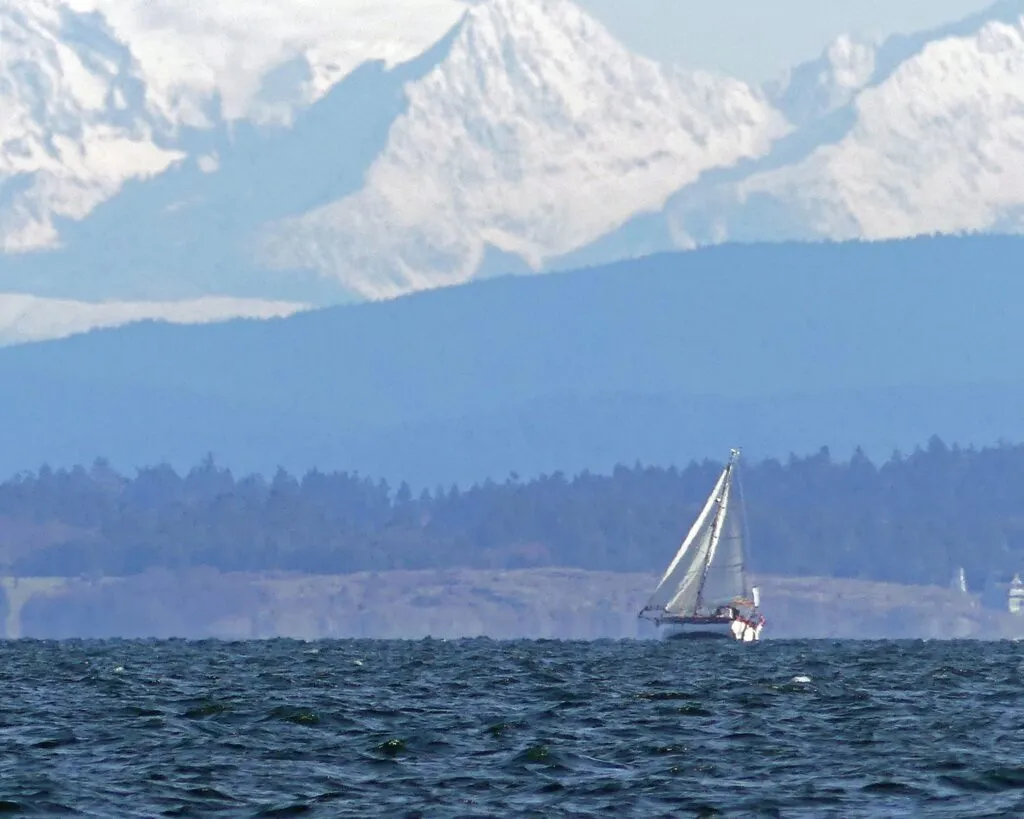
Unfortunately, Jens developed serious medical issues upon his return and was unable to continue sailing. He was determined to sell There You Are to Bill and Cathy. He wanted a sailor who could appreciate the BCC28 and care for her as she deserved. Although not really interested in a second boat, Bill thought perhaps he could keep Terrwyn in New Zealand and There You Are in Victoria, the best of both seasonal worlds.
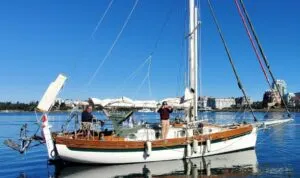
A deal was struck in the spring of 2014 and dry storage arranged for the Bristol Channel Cutter while Bill and Cathy continued with their circumnavigation aboard Terrwyn. It soon became apparent that the financial burden of 2 boats would not survive the retirement budget. Cathy had dreams of establishing roots in Victoria, while Bill aspired to a single-handed circumnavigation. After sailing Terrwyn back to Victoria, the Pacific Seacraft was on the market and Bill undertook the task of preparing There You Are for an epic solo journey. With all proper homage to King Neptune, the re-naming ceremony placed Pixie on the stern as projects began in 2016.
Bill Norrie’s 1-year circumnavigation has been well documented in local and international sailing media. He became a hero in New Zealand during the rise of Covid 19 and the dramatic conclusion of that saga was the subject of the “(Un)welcome Party” story in the May 2021 edition of Good Old Boat. But what about Pixie? There wasn’t much mention in the media of this sturdy Bristol Channel Cutter 28 that survived vast ocean gales and knockdowns.
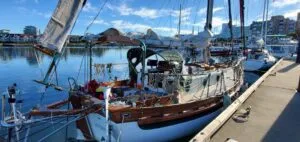
DESIGN
The Bristol Channel Cutter 28 (BCC28) is a true ocean-going sailing vessel. Designed in the early 70s, the 28 followed the lines of an earlier 24-ft. design popularized by Lin and Larry Pardey and their ocean cruising books of the 70s. Many sailing dreams were launched by those books!
The documented overall length of 28 ft. is a bit of a misnomer; add 10 ft. when including the bowsprit and boomkin! And it’s the bowsprit and boomkin that add substantially to the sail carrying ability. With a relatively short mast, these appendages stretch the size of the genoa and the length of the boom. The cutter rig allows for maximum flexibility in sail configuration, which is vital in ocean sailing.
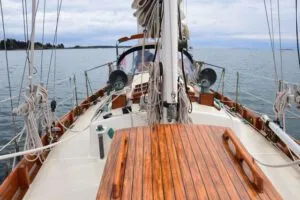
With just under a 5-ft. draft, the BCC28 is not going to get into the thinnest of waters, but stout construction brings piece of mind when the seafloor does come up unexpectedly. The relatively narrow 10-ft. beam introduces a degree of initial heel under sail, but the 4,600 lb. (2,087 kg) of lead in the keel will quickly settle her into an optimal groove. As can be expected from the full keel, maneuverability in tight quarters is not a strong point. However, minimal attention is required for sailing a straight course. The design is optimal for wind-powered self-steering devices.
CONSTRUCTION
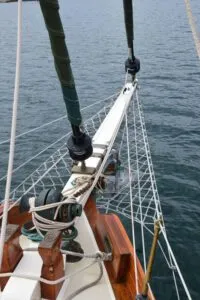
The hull is hand-laid fiberglass with a fully enclosed, full-length keel. Lead ingots form-fit the keel sump, secured with epoxy resin and then glassed into place with roving. No keel bolts to worry about. The rudder is transom hung and attached to the trailing edge of the keel, fully protected from debris or grounding.
The hull-to-deck joint is an inward turned flange with the deck set on top. Plenty of 3M 5200 is used with bolts on 5-in. centers to complete the bond. The joint is then covered by a 1 x 6 teak plank that extends out to a 3-in.-thick teak rub rail to protect the fiberglass and support the bulwarks. This massively built joint is unlikely to fail!
Internal bulkheads are glassed to the hull with 5 layers of matt for the full length of the join, adding stiffness to the hull.
The original hand-drawn and typed construction manual can still be found on the Samuel L. Morse website.
128 BCC28s were constructed in California between 1976 and 2007. Pixie is hull number 102 completed in 1994. A few of the hulls were sold as bare hulls with owners outfitting the boats themselves.
The company produced a fascinating promotional film detailing construction of the 28s from the keel to launch. In the film, the sign painter was interviewed, amongst others, while completing the name on There You Go in the shop! That film is available on YouTube.
Apparently 35 to 40 were also constructed in Vancouver, British Columbia, reportedly to the same high standards. As Canadian law did not mandate a hull number at that time, BCC28s without a hull number were undoubtedly produced there.
ON DECK AND RIGGING

The deck has a stout, traditional work boat appearance. Solid teak bulwarks, oversized deck gear and a small cockpit all point to a serious offshore contender. The double-spreader aluminum mast is keel-stepped with room on deck to work around the base. The cabin trunk is divided into a main and fore cabin. The sailor working at the mast does not have to climb onto the coach roof, which is a sensible precaution in heavy seas. Aboard Pixie, Bill has prudently arranged all sail control lines back into the cockpit for additional single-handed safety.
The aluminum boom rests on a teak boomkin mounted on bronze supports at the stern of the cockpit, which is a convenient handhold when standing in the cockpit. The boom-end mainsheet leads to traditional wooden blocks with cam cleats on the stern rail, all within easy reach of the helmsperson.
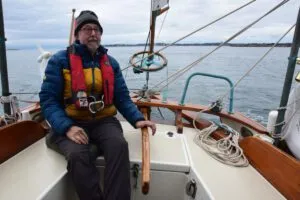
The cockpit stretches nearly gunnel to gunnel with wide seats. The view forward is excellent, even with a dodger mounted. The footwell is relatively small with a seat-level bridge across the companionway. It’s a bit of a stretch for foot bracing on the opposing seat while using the windward coaming as a comfortable back rest. Unfortunately, the teak back rest has a narrow top which eliminates the option of sitting on the coaming with a tiller extender. The teak tiller sweeps across the back ⅔ of the footwell, the crew better stay clear in tight quarters! I found that the aft rail prevented the tiller from being momentarily raised out of the way in the cockpit during a tack or gibe, a bit cumbersome with crew aboard.

A large lazarette locker is accessible though a single cockpit hatch. A person could easily climb into the locker. Bill mentioned that he is still looking to organize some of that space, perhaps a hatch to reach the back of the diesel compartment and transmission. There is certainly space here that could be better utilized.
Ground tackle has 2 rollers on the bowsprit with an ABI manual windlass at the foredeck. Hauser pipes lead the chain below into the deep forepeak. A massive Sampson post that extends below deck to the keel complete the foredeck equipment.
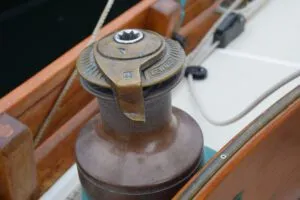
In preparation for his circumnavigation, Bill replaced all the standing and running rigging to ensure reliability. The stainless-steel deck hardware, including the winches, were replaced with bronze gear for strength and “because it looked more traditional.” Low-friction rings on loops around the teak bulwarks served as very reliable, and infinitely adjustable, sheet leads, replacing standard blocks.
A suit of cruising sails was constructed by Port Townsend Sails just south of the border in Washington State—sails that still looked strong after 365 days of exposure to the elements! A cruising spinnaker has been added to inventory since Bill’s return.
MECHANICAL
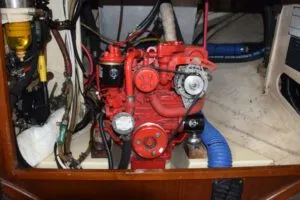
The BCC28 emerged from the factory with a Yanmar 3GM30F or, in later models, a 2002 Volvo Penta diesel tucked under the cockpit. A short shaft with the tried-and-true stuffing box leads to the propeller aperture. Aboard Pixie the previous owner, Jens, had replaced the Yanmar with a Beta 25, a Kubota-based diesel with parts readily available worldwide. The engine had 52 hours on the meter when purchased by Bill and Cathy and, following a world circumnavigation, it now has 350 hours. Engine control is a single lever against the starboard-side cockpit seat that receives its share of kicks and snagged ropes. Fortunately, it’s removable by hand and resides in a cockpit cubby while under sail.
Access to the diesel is under the companionway steps. All maintenance points are within easy reach at the front of the engine, which is a feature of the Beta design. The back-side and transmission/stuffing box are a bit more problematic. The only access is alongside the engine, where there is room, but you need to be agile! The water maker and Espar are also installed near the port hull in this compartment, which is difficult to reach.
The aluminum fuel tank mounted directly behind the engine has a 32 U.S. gal (121 L) capacity.
ACCOMODATIONS

As mentioned earlier, the cockpit has a bridge deck at seat level, necessitating a step over into the companionway. Four steep steps descend into the cabin. Cream colored panelling accented with teak trim greet the sailor in a compact interior. The cabin sole is solid fir planking. Immediately to port is a U-shaped galley with a propane 3-burner Force 10 range between a substantial storage cabinet and deep stainless-steel sink. Keeping the boat simple, Pixie has no refrigeration nor pressure water. The sink has both salt and freshwater foot pumps. The freshwater tank has a capacity of 64 U.S. gal (240 L) supplemented with the water maker aboard Pixie. There is ample storage immediately at hand for the day-to-day galley items. Counter space is as limited as expected, but only if you don’t include the opposing nav station countertop and flip-up extension.
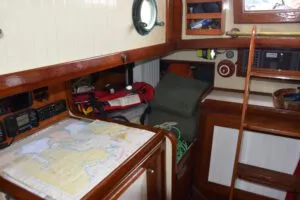
Immediately to starboard is a good-sized stand-up navigation station with a substantial chart table and room for electronics. Interestingly, under the chart table resides a large top-opening ice box. Convenient to the galley, but everything that randomly ends up on this flat surface must be removed to gain access! There is a large flip-up leaf that connects the nav station to the galley, more than doubling the available countertop and extremely helpful in the galley. It’s also helpful in spreading out full sized charts. However, it does restrict access forward to the main cabin while so deployed. Astern of the nav station is a somewhat restricted access to a full-length quarter berth that Bill uses more as a storage compartment. Batteries are underneath.
The well-equipped electrical panel is located behind the companionway steps, clearly visible and accessible with no chance of accidental contact.
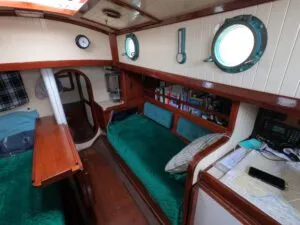
Moving forward are the 2 cabin settees. A permanently mounted drop leaf table is attached to the bulkhead as well as the mast. The starboard settee has open storage against the hull, the port side settee has a good size pilot berth. This berth can be pulled out into a double, utilizing the settee cushion. Bill finds the starboard settee with lee cloths his favorite place to put his head down.
Cabin ventilation is provided by 3 opening bronze portlights on each side of the main cabin trunk, a traditional opening teak butterfly hatch overhead accompanied by 2 bronze dorade vents. Even with spray whipping over the cabin, ventilation shouldn’t be a problem! Aboard Pixie, a propane Force 10 Cozy Cabin heater in the main cabin is supplemented with an Espar forced-air heating system aft.
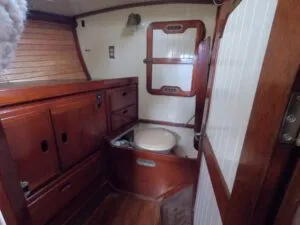
Due to the deck configuration that allows deck level access at the mast, cabin-trunk headroom stops short of the forward bulkhead. One must stoop to reach the door into the forward cabin, and then stoop even further to pass through the rounded door opening. Helmets would be useful for the first few days aboard! The forward cabin is basically the head with plenty of storage space. The toilet is hidden under a bench top and flanked by beautiful teak drawers and lockers. Fortunately, the deck doghouse provides standing headroom with a huge deck hatch and 2 opening bronze portlights. Access to more storage and the chain locker is behind the substantial teak scuttle hatch forward.
UNDERWAY
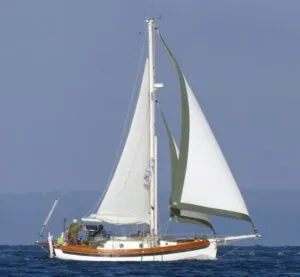
I was fortunate enough to be invited aboard Pixie for a sail on a cloudy day with light winds. Powering out of the marina onto the rippled waters of Cadboro Bay near the Victoria waterfront showed a comfortable cruising speed of 5.5 kn at 2,500 rpm. The Beta 25 has a maximum continuous engine rpm of 3,600, which is plenty of power in reserve when required. Considering that the engine compartment is mostly lacking in sound insulation, the engine noise in the cockpit was very reasonable. Vibration transmitted to the hull was at a minimum. Prop wash on the rudder was noticeable with a pull to starboard, but certainly not offensive. As anticipated, maneuverability with the full keel needed to be planned well in advance. Bill emphasized that there is no thought of directional control in reverse. However, the 3-bladed Maxi prop did serve as an admirable brake.

Sailing to windward in 7 to 10 kn of true wind, Pixie heeled slightly and soon settled into a very solid 4 to 5 kn to windward. The tiller felt solid, although somewhat heavy—the design doesn’t allow for a balanced rudder and substantial effort is needed to change direction. An over-trimmed main induced weather helm, as expected, and easing the main allowed for hands-free sailing. Pixie was able to tack through 90 degrees, both genoa and cutter sails easily passing through the fore triangle. Reaching is the Bristol Channel Cutter 28s forte. Unfortunately, the light wind during our sail did not demonstrate the potential of the Lyall Hess design. Bill, and many other BBC28 owners, can undoubtedly testify to reaching and running in comfort, despite the wind and sea conditions. In his single-handed circumnavigation, Bill ran with twin poled-out headsails, which are optimal for downwind cruising. As a long-time sailor of coastal cruisers and racing sailboats, fin keels and spade rudders, I was suitably impressed with the performance of a full keel in light airs. I expected sluggish windward ability and yet Pixie surged along effortlessly. Unfortunately, the wind never rose above 10 kn and I was unable to see how well she would performs in heavier airs.
CONCLUSION

The Bristol Channel Cutter 28 is exactly what it was designed to be—a tough, ocean crossing boat easily sailed by minimal crew or single-handed. Bill Norrie and Pixie are not the first to prove that beyond a doubt! She is not a dockside party boat with her limited cockpit, although she does tend to be somewhat of a dockside queen as the traditional design garners plenty of attention when alongside. Bill’s relentless maintenance and upgrades are most evident! Robust construction and attention to detail places this Lyle Hess masterpiece at the forefront of desirable ocean-going sailboats.




























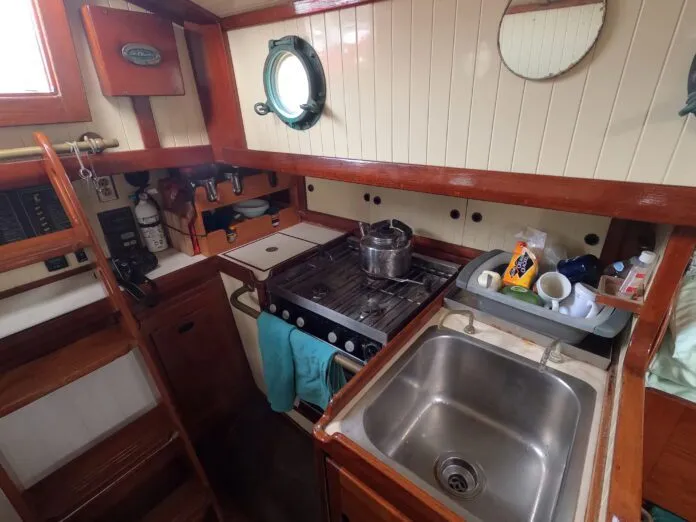





I cannot access the rest of the BCC article! Help!
I also cannot access BC28 article.
If you’re going to circumnavigate the world in one year, you’re putting yourself at high risk to be crossing an ocean when a tropical storm could develop. Not only that but you’re not going to see much or meet many people. To each his/her own.
Still can’t access the BCC28 article. Very frustrating!
Nice description of a classic. In the Nomenclature Department, perhaps the boom rests on a gallows frame, not a boomkin?
Love the classics. I have a Southern Cross 31 and can attest to their design.